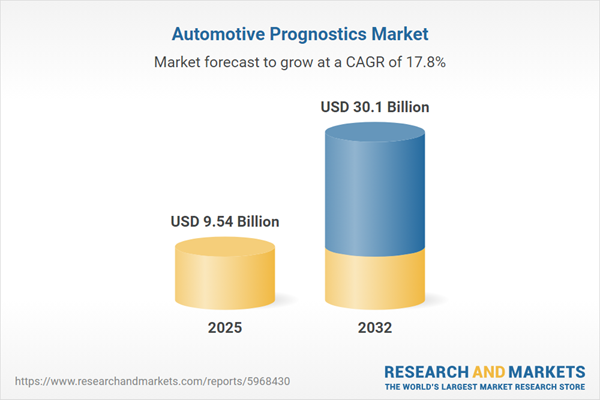Speak directly to the analyst to clarify any post sales queries you may have.
The automotive prognostics market is redefining vehicle fleet management for senior decision-makers, enabling organizations to move from reactive to predictive maintenance strategies and drive efficiency in today’s transportation sector.
Market Snapshot: Automotive Prognostics Market
Automotive prognostics is rapidly gaining traction as digital transformation prompts transportation firms to adopt advanced maintenance practices. Market momentum is intensifying as executives respond to greater pressure for operational agility and regulatory compliance. Through the deployment of robust sensors and interoperable platforms, organizations capture actionable insights across diverse vehicle portfolios, including electric, commercial, and legacy assets. This evolution supports more responsive maintenance decisions, even in markets where technology adoption has traditionally lagged. The rise in prognostics is clearly reflected across both established and emerging regions, as industry adoption is fueled by the need for increased uptime and competitive differentiation.
Scope & Segmentation: Strategic Intelligence for Executives
The report provides in-depth intelligence tailored to senior executives aiming to optimize resource allocation and investment strategy. Analysis is organized into critical segments to empower better strategic planning and operational clarity.
- Component: Diagnostics cover brake, electrical, engine, suspension, and transmission systems to enable predictive approaches suitable for varied fleets.
- Technology: The spectrum includes model-based, hybrid, and data-driven analytics to flexibly align with distinct operational objectives.
- Vehicle Type: Research encompasses commercial, passenger, and electric vehicles—including hybrids—to support informed asset deployment and maintenance schedule decisions.
- Deployment Mode: Both on-board and off-board analytic solutions are reviewed to give leaders adaptability in platform selection based on operational priorities.
- Prognostic Software Delivery: Insight into cloud and on-premise software informs decision-makers about platform scalability and security alignment for fleet maintenance.
- Service Type: The scope covers aftermarket and OEM services to allow for diagnostics continuity across a vehicle’s lifecycle.
- End User: Analysis addresses the needs of fleet operators, service providers, and vehicle owners, articulating pathways to data-driven maintenance outcomes.
- Geography: Geographic insights comprise the Americas, Europe, Middle East & Africa, and Asia-Pacific, with additional focus on innovation drivers in China, India, and Japan that are accelerating adoption.
- Industry Participants: Featured organizations include General Electric Company, Siemens Aktiengesellschaft, ABB Ltd, Schneider Electric SE, Robert Bosch GmbH, Honeywell International Inc., IBM Corporation, PTC Inc., SAP SE, and Microsoft Corporation—highlighting sector-wide initiatives toward technology standardization and robust investment trends.
Key Takeaways for Senior Decision-Makers
- Predictive maintenance positions enterprise leadership to increase operational uptime and more effectively align resources with business objectives.
- AI-driven analytics support early identification of issues in mechanical and electronic subsystems, helping minimize disruptions across diverse fleets.
- Integrating edge and centralized analytics infrastructure allows standardized maintenance processes in both localized and extended vehicle networks.
- Ensuring systems interoperability with supply chain networks and legacy IT increases the speed and ease of deploying new technologies with minimal disruption.
- Readiness to adapt to new regulatory frameworks boosts long-term operational resilience and supports overarching sustainability and electrification initiatives.
Tariff Impact and Global Supply Dynamics
Shifting tariff policies in the United States are prompting organizations to reevaluate sourcing strategies and adjust manufacturing footprints. Executive teams are broadening supplier partnerships and repositioning production activities to maintain consistent fleet operations and respond to evolving trade demands in uncertain market settings.
Methodology & Data Sources
Report findings are grounded in executive interviews with automotive industry leaders, enriched by regulatory reviews, proprietary dataset analysis, and sector-specific technical white papers. Thorough cross-validation ensures that the analysis is authoritative and directly applicable for decision-makers aiming to drive impactful results.
Automotive Prognostics Market: Why This Report Matters
- Delivers a robust benchmarking framework for evaluating predictive maintenance maturity and proactively managing risk.
- Prepares executives to navigate evolving supply chain dynamics and rapidly changing regulatory demands as fleet management models advance.
- Supplies actionable guidance for aligning innovative technologies with organizational fleet objectives.
Conclusion
This report gives senior executives the strategic roadmap needed to adopt predictive maintenance and promote enduring fleet resilience, equipping organizations to capitalize on advancements in prognostic technologies.
Additional Product Information:
- Purchase of this report includes 1 year online access with quarterly updates.
- This report can be updated on request. Please contact our Customer Experience team using the Ask a Question widget on our website.
Table of Contents
3. Executive Summary
4. Market Overview
7. Cumulative Impact of Artificial Intelligence 2025
Companies Mentioned
The companies profiled in this Automotive Prognostics market report include:- General Electric Company
- Siemens Aktiengesellschaft
- ABB Ltd
- Schneider Electric SE
- Robert Bosch GmbH
- Honeywell International Inc.
- IBM Corporation
- PTC Inc.
- SAP SE
- Microsoft Corporation
Table Information
| Report Attribute | Details |
|---|---|
| No. of Pages | 192 |
| Published | October 2025 |
| Forecast Period | 2025 - 2032 |
| Estimated Market Value ( USD | $ 9.54 Billion |
| Forecasted Market Value ( USD | $ 30.1 Billion |
| Compound Annual Growth Rate | 17.8% |
| Regions Covered | Global |
| No. of Companies Mentioned | 11 |









